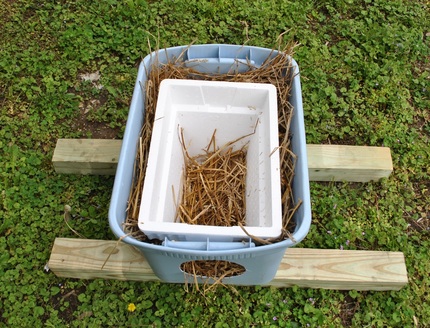How to Construct a Basic Cat Shelter

Supplies You Will Need
• Sturdy cardboard box or plastic tote with lid (ideal size 24”L x 13”W x 15”H)
• Several thin pieces of Styrofoam (about 1/4” thick) or a small Styrofoam cooler
• Straw for bedding (do NOT use hay, blankets or towels!)
• Duct tape
• Utility knife
• Ruler or measuring tape
• Marker
Instructions
1. With the box or tote sitting on the ground, top up, draw a 6” circle in the center of one (or both) of the short sides of the box. Cut out the circle to create a door(s).
2. Duct tape the edges of the circle door for reinforcement and to protect the cat from being scratched by any rough edges.
3. Measure the Styrofoam pieces so they line the bottom and the walls of the box. Cut the pieces to size and use the duct tape to secure all pieces of Styrofoam to the inside of the box. You can also use a Styrofoam cooler that will fit inside of the box/tote. Cut openings in the Styrofoam to match the door(s) in the box.
4. If using a cardboard box, fold closed three of the top flaps (allowing one of the larger flaps to stand open), and duct tape the three flaps closed. One box top flap is left unsecured to allow for easy bedding changes. If using a plastic tote, simply remove the lid to change the bedding.
5. For a cardboard box, run strips of duct tape lengthwise along the bottom of the box to help waterproof the bottom. This may be done to each side of the box for extra protection. Also, cover the entire box with a plastic table cloth or tarp (secured by heavy rocks or bricks) to prevent water damage.
6. Use a wooden pallet or bricks to elevate the shelter up off of the ground; make sure it is sturdy and will not tip once a cat climbs inside.
7. Choose a secure location for the shelter, such as under a porch or in a bushーsomewhere the shelter is protected from the weather and not exposed to potential gusty winds.
8. Clean the shelter each spring and autumn by replacing the straw bedding. You may even want to sprinkle flea powder or other flea deterrent in the bottom of the shelter, before adding the bedding. Do not allow cats to lay directly in flea powder and always read product instructions prior to use.
• Sturdy cardboard box or plastic tote with lid (ideal size 24”L x 13”W x 15”H)
• Several thin pieces of Styrofoam (about 1/4” thick) or a small Styrofoam cooler
• Straw for bedding (do NOT use hay, blankets or towels!)
• Duct tape
• Utility knife
• Ruler or measuring tape
• Marker
Instructions
1. With the box or tote sitting on the ground, top up, draw a 6” circle in the center of one (or both) of the short sides of the box. Cut out the circle to create a door(s).
2. Duct tape the edges of the circle door for reinforcement and to protect the cat from being scratched by any rough edges.
3. Measure the Styrofoam pieces so they line the bottom and the walls of the box. Cut the pieces to size and use the duct tape to secure all pieces of Styrofoam to the inside of the box. You can also use a Styrofoam cooler that will fit inside of the box/tote. Cut openings in the Styrofoam to match the door(s) in the box.
4. If using a cardboard box, fold closed three of the top flaps (allowing one of the larger flaps to stand open), and duct tape the three flaps closed. One box top flap is left unsecured to allow for easy bedding changes. If using a plastic tote, simply remove the lid to change the bedding.
5. For a cardboard box, run strips of duct tape lengthwise along the bottom of the box to help waterproof the bottom. This may be done to each side of the box for extra protection. Also, cover the entire box with a plastic table cloth or tarp (secured by heavy rocks or bricks) to prevent water damage.
6. Use a wooden pallet or bricks to elevate the shelter up off of the ground; make sure it is sturdy and will not tip once a cat climbs inside.
7. Choose a secure location for the shelter, such as under a porch or in a bushーsomewhere the shelter is protected from the weather and not exposed to potential gusty winds.
8. Clean the shelter each spring and autumn by replacing the straw bedding. You may even want to sprinkle flea powder or other flea deterrent in the bottom of the shelter, before adding the bedding. Do not allow cats to lay directly in flea powder and always read product instructions prior to use.
For more detailed information, see Chapter 10 of our Guide to Managing Community Cats.

